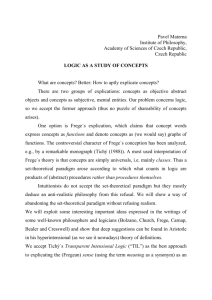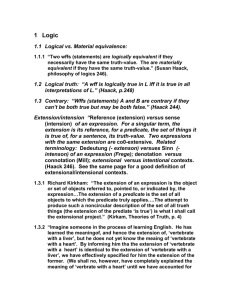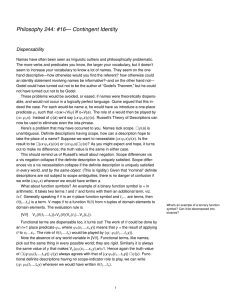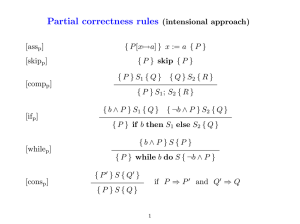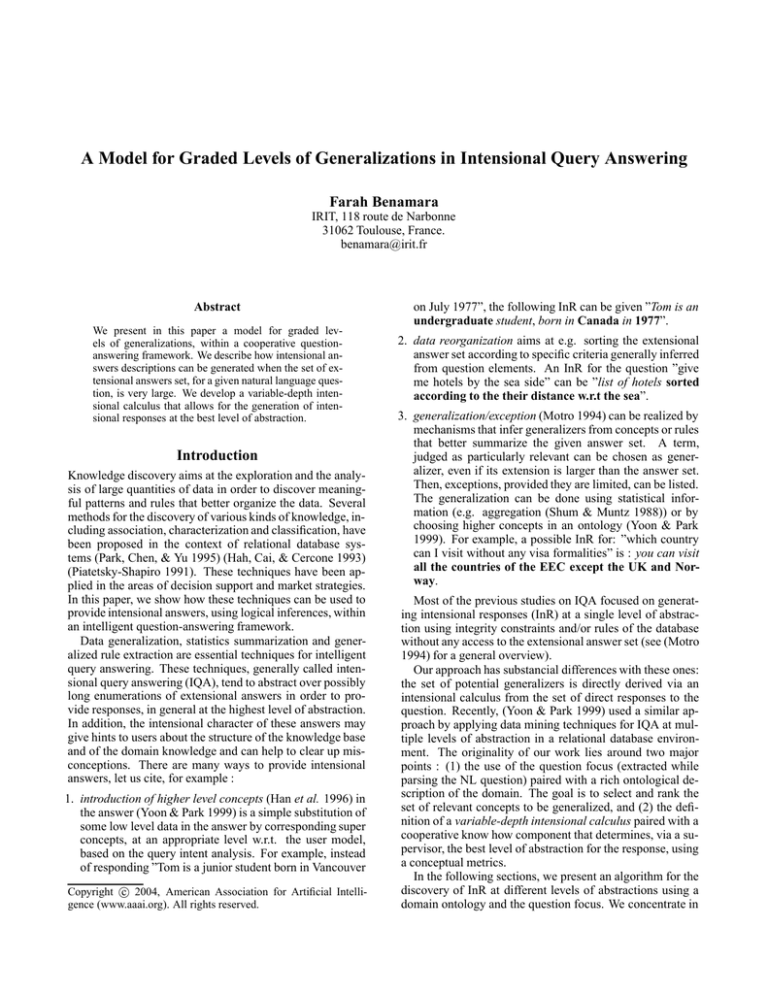
A Model for Graded Levels of Generalizations in Intensional Query Answering
Farah Benamara
IRIT, 118 route de Narbonne
31062 Toulouse, France.
benamara@irit.fr
Abstract
We present in this paper a model for graded levels of generalizations, within a cooperative questionanswering framework. We describe how intensional answers descriptions can be generated when the set of extensional answers set, for a given natural language question, is very large. We develop a variable-depth intensional calculus that allows for the generation of intensional responses at the best level of abstraction.
Introduction
Knowledge discovery aims at the exploration and the analysis of large quantities of data in order to discover meaningful patterns and rules that better organize the data. Several
methods for the discovery of various kinds of knowledge, including association, characterization and classification, have
been proposed in the context of relational database systems (Park, Chen, & Yu 1995) (Hah, Cai, & Cercone 1993)
(Piatetsky-Shapiro 1991). These techniques have been applied in the areas of decision support and market strategies.
In this paper, we show how these techniques can be used to
provide intensional answers, using logical inferences, within
an intelligent question-answering framework.
Data generalization, statistics summarization and generalized rule extraction are essential techniques for intelligent
query answering. These techniques, generally called intensional query answering (IQA), tend to abstract over possibly
long enumerations of extensional answers in order to provide responses, in general at the highest level of abstraction.
In addition, the intensional character of these answers may
give hints to users about the structure of the knowledge base
and of the domain knowledge and can help to clear up misconceptions. There are many ways to provide intensional
answers, let us cite, for example :
1. introduction of higher level concepts (Han et al. 1996) in
the answer (Yoon & Park 1999) is a simple substitution of
some low level data in the answer by corresponding super
concepts, at an appropriate level w.r.t. the user model,
based on the query intent analysis. For example, instead
of responding ”Tom is a junior student born in Vancouver
c 2004, American Association for Artificial IntelliCopyright gence (www.aaai.org). All rights reserved.
on July 1977”, the following InR can be given ”Tom is an
undergraduate student, born in Canada in 1977”.
2. data reorganization aims at e.g. sorting the extensional
answer set according to specific criteria generally inferred
from question elements. An InR for the question ”give
me hotels by the sea side” can be ”list of hotels sorted
according to the their distance w.r.t the sea”.
3. generalization/exception (Motro 1994) can be realized by
mechanisms that infer generalizers from concepts or rules
that better summarize the given answer set. A term,
judged as particularly relevant can be chosen as generalizer, even if its extension is larger than the answer set.
Then, exceptions, provided they are limited, can be listed.
The generalization can be done using statistical information (e.g. aggregation (Shum & Muntz 1988)) or by
choosing higher concepts in an ontology (Yoon & Park
1999). For example, a possible InR for: ”which country
can I visit without any visa formalities” is : you can visit
all the countries of the EEC except the UK and Norway.
Most of the previous studies on IQA focused on generating intensional responses (InR) at a single level of abstraction using integrity constraints and/or rules of the database
without any access to the extensional answer set (see (Motro
1994) for a general overview).
Our approach has substancial differences with these ones:
the set of potential generalizers is directly derived via an
intensional calculus from the set of direct responses to the
question. Recently, (Yoon & Park 1999) used a similar approach by applying data mining techniques for IQA at multiple levels of abstraction in a relational database environment. The originality of our work lies around two major
points : (1) the use of the question focus (extracted while
parsing the NL question) paired with a rich ontological description of the domain. The goal is to select and rank the
set of relevant concepts to be generalized, and (2) the definition of a variable-depth intensional calculus paired with a
cooperative know how component that determines, via a supervisor, the best level of abstraction for the response, using
a conceptual metrics.
In the following sections, we present an algorithm for the
discovery of InR at different levels of abstractions using a
domain ontology and the question focus. We concentrate in
this paper on data reorganization and on the production of
generalization/exception responses. Results are integrated
and evaluated within the WEBCOOP project (Benamara
& Saint-Dizier 2004), an intelligent, cooperative questionanswering system.
The Discovery of InR : the framework
Our general framework is WEBCOOP, a logic based question answering system that integrates knowledge representation and advanced reasoning procedures to generate intelligent or cooperative responses to NL queries on the web.
A general overview of the system is given in (Benamara
& Saint-Dizier 2004). In WEBCOOP, responses provided
to users are built in web style by integrating natural language generation (NLG) techniques with hypertexts in order
to produce dynamic responses. NL responses are produced
from semantic forms constructed from reasoning processes.
During these processes, the system has to decide, via cooperative rules, what is relevant and then to organize it in a way
that allows for the realization of coherent and informative
responses. In WEBCOOP, responses are structured in two
parts : (1) the production of explanations that report user
misconceptions and then (2) the production of flexible solutions that reflect the cooperative know how of the system.
This component is the most original. It is based on intensional description techniques and on intelligent relaxation
procedures going beyond classical generalization methods
elaborated in artificial intelligence. This component also
includes additional dedicated cooperative rules that make a
thorough use of the domain ontology and of general knowledge. This paper deals with the intensional component.
Knowledge Representation in WEBCOOP
WEBCOOP has two main sources of information: (1)
general knowledge and domain knowledge represented by
means of a deductive knowledge base, that includes facts,
rules and integrity constraints and (2) a large set of indexed
texts, where indexes are logical formulae. Our system being
a direct QA system, it does not have any user model.
The first source includes basic knowledge (e.g. countries,
distances between towns), and ontological knowledge. Ontologies are organized around concepts where each concept
node is associated with its specific lexicalizations and properties. For example, the concept hotel has the specific
properties night-rate and nb-of-rooms. Values associated with scalar properties allow for sorts, useful for category (2) above. The aim is to sort concepts according to
specified dimensions.
We assume that the most relevant documents w.r.t the
user question are found using standard information retrieval
techniques and that the relevant paragraphs that respond to
the question keywords are correctly extracted from those
documents. Then, our knowledge extractor transforms
each relevant paragraphs into the following logical representation: text(F, http) where F is a first-order formula
that represents some knowledge extracted from a relevant
paragraph with address http (Benamara & Saint-Dizier
2003). For example, the following text fragment :
....three star hotels in Cannes....
is represented by:
text(hotel(X)
∧
localization(X, in(cannnes))
city(cannes) ∧ category(X, 3star), www.cote.azur.f r).
∧
Query Representation and Evaluation
The parse of a query allows to identify: the type of the
query (yes/no, boolean or entity), the question focus and
the semantic representation of the query in first-order logic
(conjunctive formula). For example, the question:
Q1: what are the means of transportation to go to Geneva
airport
has the following logical representation: (entity, Y :
meansof transportation,
route(X) ∧ to(X, Z)
bymeansof (X, Y )
∧
meansof transportation(Y )
airportof (Z, geneva)).
∧
∧
Evaluating a query is realized in two steps. First, we have
to check if the question is consistent with the knowledge
base. If neither a misconception nor a false presupposition
is detected then the extensional answer set that corresponds
to the question can be found in two different ways: (1) from
the deductive knowledge base, in that case, responses are
variable instances or (2) from the indexed text base, and in
that case, responses are formulae which subsumed with the
query formula. Roughly, unification proceeds as follows.
Let Q (conjunction of terms q i ) be the question formula and
F (conjunction of f j ) be a formula indexing a text. F is a
response to Q iff for all q i there is an fj such that:
1. qi unifies with fj or
2. qi subsumes, via the ontology, f j (e.g.
transportation(Y) subsumes tramway(Y)), or
means-of-
3. qi rewrites, via rules of the knowledge base, into a conjunction of f j , e.g.: airportof (Z, geneva) rewrites into:
airport(Z) ∧ localization(Z, in(geneva)).
An Algorithm for the construction of InR
Given the set of extensional answers to a question, which is,
in most cases, formulas, as explained above, content determination of an InR is defined as follows: (1) search in the answer set or in a related node in the ontology for the adequate
element to be generalized, then (2) find the best level of abstraction for the answer, possibly including a list of exceptions. An intensional supervisor (cf. next section) manages
the different operations, including non-determinism (variable depth intensionality) using a conceptual metrics.
The discovery of InR begins by searching in the answer
set a relevant generalized element. It is important to note,
that our algorithm identifies and eliminates those predicates
in the response that are not relevant for the abstraction task,
e.g. predicates that have the same instanciations in the response logical formula, and predicates that does not have
any entry in the domain ontology such as hotel names.
The algorithm that searches for the best element to generalize is as follows:
1. check if the list of extensional answers includes a term
that can be generalized or sorted using the question focus.
For example, the question Q1 above can have the following InR : all public transportation and taxis go to Geneva
airport where the extensional answers, e.g. buses, trolleys
and trains, are generalized using the type of the question
focus means of transportation.
2. else, search in the question for a property associated with
the focus that has variable values in the answer set. For
example, the list of answers to the question :
hotel(X)∧localization(X, [atborderof (Y ), in(monaco)])∧
sea(Y ) ∧ city(monaco)
(what are the hotels at the border of the sea in Monaco)
cannot be generalized using the focus hotel(X) which
corresponds to hotel names and is therefore eliminated,
as described above. The property localization of the
concept hotel is selected because all extensional answers
include the distance of the hotel to the sea, (distance
which is an instance of the semantics of atborderof(Y)).
A possible InR is then the list of hotels in Monaco sorted
according to their increasing distance to the sea.
3. else, search in the ontology for a property related to
the focus on which a generalization can be made. For
example, if we ask for hotels in Cannes with a swimming
pool represented by the formula
hotel(X)
∧
localization(X, in(cannes))
equipment(X, Y ) ∧ swimmingpool(Y ),
∧
no possible generalizer can be found neither on the focus
X, nor on its properties, localization and equipment. So a
possible InR is : ”3 stars and 4 stars hotels in Cannes have
a swimming pool” where the generalization is realized on
the property ‘hotel category’ associated with the concept
hotel.
4. else, no InR can be generated. The answer list is simply
enumerated without any intensional treatment.
Given the element in the response on which intensional
calculus operates, the next stage is to find the best level
of abstraction. Considering the set of instances of this element in the answer set, generalization proceeds by grouping instances by generalizable subsets w.r.t. the ontology.
This procedure may be repeated until a single generalizer
is found, if it exists, possibly with a few exceptions. The
following examples illustrate our approach.
extensional answers set: trains, buses and taxis. According
to the ontology described in figure 1, this question has the
following generalization levels:
1. InRa : all intercity and all suburban trains of Geneva, taxis
and buses go to the airport,
2. InRb : all rail transportations, buses and taxis of Geneva
go the airport,
3. InRc : most public transportations and taxis of Geneva go
to the airport,
4. InRd : most means of transportation of Geneva go to the
airport.
InRa to InRc are possible generalizations, InR d is correct,
but not very informative because of its proximity to the
query1.
Example 2. Suppose someone asks for 3 star county
cottages in southern France between 1 th and 10th August :
Q2 = (entity, X
: country cottage, stay(W ) ∧
accommodation(W, X)∧
∧
localization(X, in(Z))
∧
county cottage(X)
southf rance(Z) ∧ category(X, 3star)∧
period(W, P ) ∧ between(temp, P, 1august, 10august)).
Suppose, again, that the inference engine retrieves more
than 40 available 3 star country cottages located in different
regions in south France, among which :
- county cottages in Foix,
- county cottages in Carcassonne,
- county cottages Pradis in Cannes,
- etc.
This question can be generalized using the property
localization associated to the focus country cottage (step
2 of the algorithm). According to the following ontology
fragment :
Example 1. Suppose the following fragment of a transportation ontology such as described in the following figure.
Figure 2: A fragment of a region ontology
and to the corresponding extensional answers set, the
question Q2 can have the following generalization levels :
Figure 1: A fragment of the transportation ontology
Suppose again, that the question Q1: what are the means
of transportation to go to Geneva airport has the following
1. InRe : 3 star available country cottages in : Aquitaine except for the Landes department, in Midi Pyrénées except
for the Tarn department, in Languedoc Roussillon and in
Provence Alpes Côte d’Azur regions.
1
The query itself is often the only InR of the retrieved set of
values of which the user is aware (Motro 1994)
2. InRf : 3 star available country cottages in south eastern
regions and in south western regions except for the Landes
and the Tarn countries,
3. InRg : 3 star available country cottages in south France
regions except for the Landes and the Tarn countries.
These examples show that our algorithm derives graded
levels of generalizations. It is then necessary to select responses at the best level of abstraction. (Cholvy & Demolombe 1986) performs a syntactic check on the response
set that selects only those IA that are not logically subsumed
by any others (e.g. IA c above). They also used another criterion which aims at limiting the set of interesting IA only
to answers which share the same vocabulary defined by the
user in his question in term of concepts, properties and constants. These techniques are simple and not adequate for our
purpose since, first, the choice of the best level of abstraction is automatically performed and, second, we want to give
users the possibility of choosing the type of intensional answer which is the most appropriate for them. This is, in our
sense, more cooperative, provided the system is not too verbose.
A Supervisor for intensional calculus
In our case, a supervisor manages both the abstraction level
and the display of the elaborated InR. In WEBCOOP, we
have a variable depth intensional calculus which allows the
user to choose the degree of intensionality of responses in
terms of the abstraction level of generalizers in the ontology.
This choice is based on a conceptual metrics M (C, C ) that
determines the ontological proximity between two concepts
C and C’ (Budanitsky & Hirst 2001). Considering the form
of our ontology, roughly, our similarity metrics considers
the sum of the distance in the ontology between the two
concept C and C’ in terms of the number of arcs traversed
combined with the inverse proportion of shared properties,
w.r.t the total number of properties on these nodes. This
metrics is defined as follows :
M (C, C ) = N bArc(C, C ) +
Card(prop(C)∪prop(C ))
Card(prop(C)∩prop(C ))
The variable depth intensional calculus
Let ResponseSet = {InR1 , ..., InRn } the set of possible generalization levels for a given question and
let generalizer(InRi) a function that returns the
list of generalizers for the response InR i with :
InRi = all Gen1 and...and all Genj .
The variable
depth intensional calculus is implemented by the predicate :
var depth(ResponseSet, Choice) where the best level
of abstraction that corresponds to the variable Choice is
determined using the following rule :
var depth(ResponseSet, Choice) −→
list metrics(ResponseSet, M Set),
max(M Set, Choice),
where, list metrics(ResponseSet, M Set) computes for
each InRi ∈ ResponseSet, the value of M (Gena , Genb )
with Gena , Genb ∈ generalizer(InRi) (1 ≤ a ≤ j, 1 ≤ b ≤ j
and a = b) which corresponds to the conceptual distance
between the generalizers Gen k . Then, depending on the
variable M Set, the choice of the best level of abstraction
is made as follows. If this metrics shows an important
distance between concepts, then it is more appropriate to
stay at the current level of abstraction. Otherwise, it is best
to replace two similar concepts by their immediate mother
concept in the ontology, and recursively for the other Gen k .
If we go back to the example 1 in the last section, the
supervisor computes, for the response InR b , the metrics
M(bus, taxi), M(train, taxi) and M(train, bus). After the
computation of the metrics associated to each response level,
this strategy allows to choose the InR b as the best summary.
The same strategy is used in example 2, where, for example, for InRf the metrics M(south eastern, south western) is
computed. Finally, InR f is chosen to be the best level of
abstraction.
The response display strategy
The organization of the response display is as follows. The
retrieved intensional answers are structured in two parts.
First, the generation of an InR that corresponds to generalization and/or exception of the extensional answers set and
then the generation of InRs that corresponds to (1) a sorted
list (if responses can be sorted) of the retrieved extensional
answers according to different criteria, identified as sortable
or (2) another kind of generalization. This strategy avoids
the problem of having to guess the user’s intent. In example
1 of the previous section, the extensional answers set for the
question Q1 can be sorted according to two different criteria:
the frequency and the cost. In example 2, the list of available
3 star country cottages can be generalized according to the
kind of leisure activity practiced in the country cottage like
fishing or riding. This criteria is one of the properties of the
concept country cottage in the domain ontology.
This second part is best viewed as the expression of the
cooperative know-how of the system. For the moment, the
maximum number of InR given in the second part is fixed to
three which seems to be a manageable number of possibilities. If the number of ordering criteria, for a given concept
or property in the ontology, is greater than three then the system arbitrarily chooses three of them. This strategy is still
under evaluation.
InR are displayed in our system WEBCOOP using an hyperlink presentation that allows the user to view either the
intensional definition of the generalized classes or their extensional enumeration. Because the user is familiar with the
concepts he or she is using, we try to keep in the natural
language responses, as much as possible, the same syntactic
structure and lexicalizations as in the question. The following figures illustrate how intensional answers are displayed
in WEBCOOP, for both the two examples in the last section,
as explained above.
Conclusion and Perspectives
We proposed in this paper a method for discovering graded
levels of generalizations in a cooperative question answer-
• investigate other metrics in order to enhance the system
capabilities for choosing the best level of abstraction,
• introduce a user model for the selection of the best response.
References
Figure 3: Intensional answers in WEBCOOP: example 1
Figure 4: Intensional answers in WEBCOOP: example 2
ing framework when the set of extensional answers set, for
a given natural language question, is very large. The originality of our approach mainly lies in the use of the question
focus and a rich ontological description of the domain, in order to select a set of relevant concepts to be generalized. We
develop a variable depth intensional calculus which allows
for the generation of intensional answers at the best level of
abstraction. A supervisor guides this process using a conceptual metric and manages the response display by structuring InRs in two parts, allowing for a mixed and graded
generation of InRs based on different criteria.
On the basis of (Motro 1994), IQA can be evaluated according to three main features : (1) intensional only (pure) versus intensional/extensional (mixed) ; (2) independence from
the database instances versus dependence and (3) completeness of the characterization of the extensional answers. Our
approach is mixed, dependent and complete since our algorithm computes all non redundant InRs.
For the moment, we are evaluating the linguistic and the cognitive adequacy of the generated intensional answers using
an experimental psychology method since an evaluation in
TREC style (Voorhees 2002) is not adequate for our purpose. We have developed several experimental protocols and
interpretation results are ongoing. In the future, we plan to :
• integrate integrity constraints in the intensional calculus.
In this case, the InR will be pure.
Benamara, F., and Saint-Dizier, P. 2003. Knowledge Extraction from the Web: an Experiment and an Analysis of
its Portability. revue Vivek, volume 15, numro 1 3–15.
Benamara, F., and Saint-Dizier, P. 2004. Advanced Relaxation for Cooperative Question Answering. New Directions
in Question Answering, Chapter 21 A paratre.
Budanitsky, A., and Hirst, G. 2001. Semantic distance
in wordnet: An experimental, application-oriented evaluation of five measures. In Workshop on WordNet and Other
Lexical Resources, Second meeting of the North American
Chapter of the Association for Computational Linguistics.
Pittsburgh, PA.
Cholvy, L., and Demolombe, R. 1986. Querying a Rule
Base. Expert Database Conf 477–485.
Hah, J.; Cai, Y.; and Cercone, N. 1993. Data-driven discovery of quantitative rules in relational databases. 29–40.
Han, J. W.; Huang, Y.; Cercone, N.; and Fu, Y. J. 1996. Intelligent Query Answering by Knowledge Discovery Techniques. IEEETrans. On Knowledge And Data Engineering
8:373–390.
Motro, A. 1994. Intensional Answers to Database Queries.
IEEE Transactions on Knowledge and Data Engineering,
volume 6 number 3. 444–454.
Park, J.; Chen, M.; and Yu, P. 1995. An effective hash
based algorithm for mining association rules. In Proc. ACM
SIGMOD Intl. Conf. Management of Data, May.
Piatetsky-Shapiro, G. 1991. knowledge discovery in
database. AAAI, MIT press.
Shum, C., and Muntz, R. 1988. An Information-Theoretic
Study on Aggregate Responses. In Proceedings of the 14th
VLDB Conference 479–490.
Voorhees, E. M. 2002. Overview of trec 2002. In NIST
Special Publication 500-251: The Eleventh Text Retrieval
Conference.
Yoon, S.-C., and Park, E. K. 1999. An Approach to Intensional Query Answering at Multiple Abstraction Levels
Using Data Mining Approaches. Proceedings of the 32th
Hawaii conference on System Sciences.

